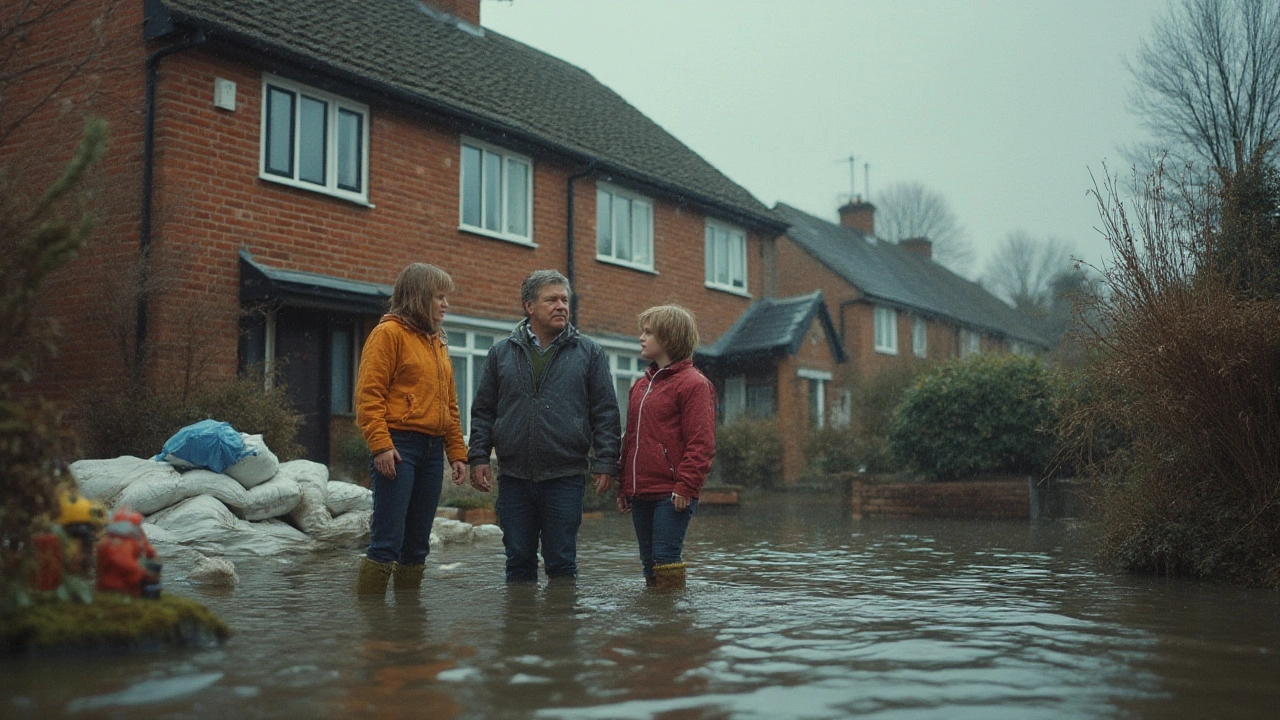If you think your homeowners insurance will protect everything inside and around your house, you’re in for a wild surprise. Plenty of folks discover—usually in a moment of total panic—that their biggest risks aren’t covered at all. That soggy basement from a heavy rainstorm or your brand-new gaming console fried by a power surge? Those can easily fall through the cracks. Some exclusions make sense, but others seem like something only a lawyer would come up with. Understanding these gaps before trouble knocks can mean the difference between a tiny headache and a full-blown financial meltdown.
Common Disasters Your Policy Won’t Touch
Let’s talk about the heavy hitters first: natural disasters almost no standard policy covers. Floods usually top the list. Your typical homeowners insurance flat-out denies claims for water rising from riverbanks, overflowing lakes, or even heavy rain that seeps through doors and windows. Hurricanes? Sure, wind damage gets some love, but the water piled up later—nope, you’re on your own. For that, you’d need to buy separate flood insurance (check FEMA stats: only about 18% of American homes have it!). Now earthquakes are a whole different beast. When the ground shakes, cracks, or swallows entire rooms—don’t expect your insurer to swoop in. California and a few other states with wild seismic histories push special quake coverage, but most places leave you to fend for yourself.
Sinkholes and landslides also get no sympathy. You might think your kitchen dropping into a cavity is a clear claim. Nope! Most policies slip sinkholes into the fine print exclusions. And mudslides after a heavy downpour? The insurance company will likely quote their “earth movement” clause and deny you. Even volcanoes (rare here, but ask folks in Hawaii) can burn a massive hole in your pocket if your base policy doesn’t mention them directly.
Personal Property Gaps: What’s Left Out and Why
It’s easy to assume all your stuff is protected, but home insurance also limits or completely skips certain items. High-value jewelry, for one. That shiny diamond ring Grandma passed down usually has a coverage cap—sometimes only $1,500, which barely covers today’s wedding bands. Electronics can be another trap. Big-screen TVs and gaming PCs might get some partial coverage, but there’s often a total dollar limit or even an outright exclusion for “power surge” damage. If Luna the dog chews through your fancy speakers? The policy isn’t paying for that either.
Cash, rare coins, and collectibles? Tiny compensation, often less than $200. That signed baseball, vintage comic, or limited-edition guitar—unless you added a special rider—might as well be uninsured. And don’t forget about business equipment. The pandemic made home offices common, but policies keep a low cap for valuables tied to a business—usually only a few thousand dollars total. If you run an Etsy shop out of your garage, or keep tools for contract work, double-check your limits. Don’t assume you’re protected.
Here’s a little table showing standard property sub-limits you might see (actual limits vary by insurer but these are pretty typical):
| Item Type | Typical Limit |
|---|---|
| Jewelry, Watches | $1,500 |
| Firearms | $2,500 |
| Cash | $200 |
| Electronics | $1,000 - $2,500 |
| Business Property | $2,500 |
| Silverware, Gold, Fine Art | $2,500 |
Always ask your insurance rep about specific items that matter to you. Most companies let you “schedule” (aka separately insure) expensive stuff for a few extra dollars a year. It’s boring, but a quick inventory with photos and receipts can save hours of arguing after something goes missing or breaks.

Wear, Tear, and Negligence: When Damage Is on You
People love their homes, but hardly anyone reads the thick policy booklets insurers provide. If you did, you’d find pages explaining how insurers draw the line on regular wear and tear or plain old neglect. So, if your roof slowly leaks over a few years, leading to mold or rotted rafters, don’t count on a check. Insurance companies expect you to keep up with routine maintenance. Same goes for burst pipes caused by letting the house freeze in winter because you skipped turning on the heat.
Negligence exclusions can get downright personal. If you knew that tree in the backyard was dead and didn’t remove it, then it fell during a windstorm, wrecking your garage—the insurance company has a well-practiced “nope” waiting. Let’s say you adopted a rescue puppy (hello, Luna!) and she chews a big hole in your new carpet or destroys half the furniture. Pet damage? Usually excluded! Insurance isn’t there for slow problems or preventable ones, just the sudden and unexpected kind—think fire, theft, or a burst pipe (as long as you didn’t forget to winterize).
There’s even a name for these little homemade disasters: “maintenance exclusions.” Some common ones:
- Gradual water damage from leaky pipes
- Mold and fungus, unless caused by a listed disaster
- Termite and pest infestations
- Wear and tear on appliances
- Corrosion or rust
- Foundation settling and cracking
Policy Exclusions That Usually Surprise Homeowners
Here’s a scenario I ran into with a neighbor last spring: Her basement flooded after a long rain, but the damage wasn’t from a broken appliance or an overflowing fixture. It was just groundwater, creeping in through cracks. Her claim? Denied. Water backup coverage and flood insurance both would’ve protected her, but she had neither. And while hail and wind get attention, power outages caused by those storms aren’t usually covered—so that spoiled fridge full of food? Unless you bought a special endorsement for food spoilage, the loss is yours.
Acts of war and nuclear accidents also fall in the “no way” pile. You might think I’m kidding, but if your home gets flattened by a nearby plant meltdown, standard home insurance isn’t your savior (the government has separate programs for really big disasters). Similar black holes in coverage include government seizures—like the city condemning your property during major roadwork, or taking your land for construction. Civil unrest or riots sometimes ride under “named perils” policies, so make sure you aren’t assuming you’re protected unless the paperwork states it in black and white.
DIY renovations come with their own headaches. If you accidentally knock a load-bearing wall out trying to “open up the space,” that’s not an insurance problem. And if an unlicensed friend gets hurt while helping you on a Saturday, medical payments and liability coverage may toss you to the wolves. Always check if “all risk” liability covers volunteers or just official contractors who can show their own proof of insurance. Speaking of liability, dog bites or accidents caused by certain “dangerous” breeds can be excluded—even if Luna’s a sweetheart, some companies put entire breeds on their no-go list.

Tips to Plug the Gaps and Dodge Financial Trouble
Odds are, you’re thinking, “How do I keep from getting burned?” Start with a thorough review of your policy’s homeowners insurance exclusions—not just the highlights agents love to mention, but that gritty fine print. Next, map out a list of stuff that matters: jewelry, rare collectibles, big-dollar electronics, and any hobby gear (think camera equipment, musical instruments, or home gym machines). For each item, check if the default limit matches today’s replacement price. Nine times out of ten, you’ll want a rider or “endorsement” for the valuables.
Don’t sleep on flood or earthquake insurance if you live in a risky area—even if the weather seems calm now. With climate change sparking unpredictable storms, FEMA reports say more than 40% of 2024’s flood insurance claims came from supposedly “low-risk” zones. A $300/year policy is much easier to handle than losing your whole basement stash.
On the maintenance front, set up reminders for seasonal checkups: roof inspections every spring and fall, pipe checks before winter, and pest inspections yearly. Snap pictures of upgrades and keep digital copies of receipts. If you run a side business out of your home, call your agent about a business endorsement—a regular policy simply isn’t built for commercial equipment or inventory.
Pets, pools, and trampolines are magnets for lawsuits—so call your insurer before picking up the latest rescue pup or putting something fun in the yard. If your liability limits look light, a $1 million umbrella policy usually costs less per month than streaming TV. And since wildfires have been tearing through neighborhoods across the West and South in 2025, double-check that your local risk is accurately reflected in your premiums. If wildfire isn’t mentioned, ask why.
Most importantly, shop around every couple of years—what you needed in 2020 might look laughable today. Get competing quotes, ask blunt questions, and never assume one-size-fits-all. Unless you love surprises—most of us really don’t, at least when it comes to insurance.
